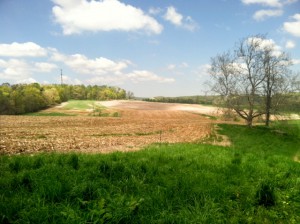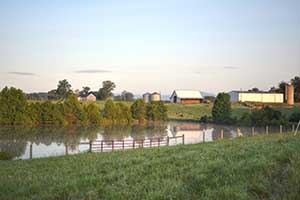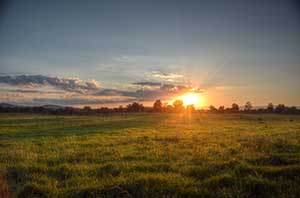 Chances are if you’re reading this, you are contemplating or have already purchased a beautiful piece of land or farm. A Virginia farm around Charlottesville and/or the Piedmont region is likely a resplendent piece of property, but it may require a little work before you can harness its full potential. Are you currently in possession of land that is, in its current state unsuitable for the construction of domiciles, rearing of livestock, cultivation of vineyards or any of the other various sundry things for which land in Virginia can be utilized? If you have found yourself deliberating the best way to clear your land, look no further than this guide! Here we give you a surface look at several different land clearing methods.
Chances are if you’re reading this, you are contemplating or have already purchased a beautiful piece of land or farm. A Virginia farm around Charlottesville and/or the Piedmont region is likely a resplendent piece of property, but it may require a little work before you can harness its full potential. Are you currently in possession of land that is, in its current state unsuitable for the construction of domiciles, rearing of livestock, cultivation of vineyards or any of the other various sundry things for which land in Virginia can be utilized? If you have found yourself deliberating the best way to clear your land, look no further than this guide! Here we give you a surface look at several different land clearing methods.
There exists among new landowners a tendency to want land cleared as quickly as possible, without considering all options. Most people do what is quickest and least-time consuming. The most conventional way in which land is usually cleared is to harvest the timber (by harvest, we mean either sell it or use it for their own projects later on), bring in a bulldozer or similar machine to remove the stumps, and then swiftly lay down the next layer (whether it be buildings, open pastures, riding arenas, or asphalt to construct a parking area). This method can be one of the most cost-effective ways to get rid of unwanted components on your land, and because it’s so common, it’s actually quite easy to find people to get this work done; there is certainly a ready market for it. However the bulldozer may cost more than expected, especially if you are unable to leverage the cost of the work against the expected value of the timber. Either way, you’ll end up with what is known as “waste-wood”; stumps and unmarketable pieces of wood. There are a couple of things you can do with the wood, and options vary based on financial and temporal constraints.
You can burn the wood. This is a fairly simple maneuver that gets rid of most of the waste-wood. You can either stack it up into piles and burn it, or dig a hole, burn the waste-wood and bury it. Neither method is extremely kind to the environment; burning that much waste-wood will undoubtedly release greenhouse gasses into the air. You’ll never get rid of all the excess wood with these methods, and you will likely have to check with your local fire department or the Virginia Department of Forestry before taking these measures. In the latter instance, all that charred waste-wood you buried could develop into sinkholes, which is definitely a less-than-desirable circumstance. You could also stack the wood into piles and leave it to eventually decompose. This is much easier and essentially free or very cheap (if using hired labor). The downsides are that the piles of rotting wood on your property would become kind of an eyesore and may develop weeds over time. It does have some benefits for the soil though and the wildlife love it.
If you somehow want to harness the waste-wood, you have a couple of options. The idea of waste-wood utilization maximizes the economic gains you derive from your property. You can use the wood for a variety of things including firewood, hobby wood, custom sawing, and others. If you are in a hurry to develop your land, this may not be the most time-effective method; you’d also need access to a variety of other resources (such as a sawmill) or professionals who can use such things expertly. It may not be cheap to pay them, but the idea is to derive your return from the wood. Similarly, you could use a tub grinder and turn the waste-wood into mulch for personal use or resale. There are machines fitted with mulching implements as this practice has becomes increasingly common. With this method, you can preserve soil integrity* (read below) and get stumps and other debris up quickly. Some of the machines even chip stumps and other debris and feed it back into the soil, increasing organic matter and reducing erosion. This is good if you plan on using the land for pastures, as it maintains soil health. It’s not very cost-effective, although it depends on the soil. The process can range from $200 to $1200 an hour. But certain materials like pine are easier to process than others. The smaller the surface area to be mulched, the easier and more affordable it becomes. It’s not really a viable option for rocky sites.
Bulldozing can sometimes be the quickest, most efficient way to clear your land. But if time and cost-efficacy aren’t your only considerations, you may think about other options. *Many of the farms in rural Virginia only have a few good inches of topsoil, and nearly all of that is in jeopardy when running a bulldozer over the land and razing the ground. Decomposing leaves and branches contribute to the layers of topsoil, and ripping the roots of a tree out of the ground depreciates the topsoil, which has specific nutrients and organic matter that contribute to the growth and cultivation of healthy grass, lawn and pasture area. If you are planning on clearing the land for uses like this, you may want to think about alternative methods, because you will be faced with increased costs and will have to spend time undoing some of the damage to the soil.
Waiting to Remove Stumps
This is an avenue that does not receive as much consideration. Oftentimes, people are in a hurry to develop on the land and fail to consider this viable option. However, simply waiting for the stumps to decompose does less damage to your land and your wallet.
If you’re dealing with pine, letting the stumps decompose after a timber harvest is a pretty good option. The stumps will decompose fully between three and five years, unless of course you’re dealing with shortleaf pine, which will sprout up anew on dead stumps and is quite vigorous.
Deciduous trees are different beasts entirely, because—like shortleaf pine—the trees sprout tenaciously on the stump unless the actual root system itself is destroyed. Generally speaking, herbicides are the cheapest, most effective way to kill roots. Simply fell a tree and, 15 minutes after (if you’re using a water-based solution) or one hour (if you’re using an oil-based solution), apply the herbicide to the stump. The stump should absorb the herbicide and distribute the solution to the root system, effectively killing the tree. One of the problems associated with herbicides is that they have to be applied so soon after cutting down the tree. To address this, people leave the stump a little higher than they normally would; they can then do a follow-up cut when it’s more convenient, right when they have the herbicide on hand. “Herbicides” sound pretty harmful and toxic (due in no small part to the name), but the marginal amount of soil toxicity is actually far less harmful than uprooting the stump, which leads to erosion and the aforementioned degradation of topsoil.
Goats
Goats are actually very effective as biological clearing agents. You can buy goats to harvest and clear underbrush, smaller trees and bushes and then sell them once you’ve cleared your land to the extent you desire. Many people see goats as “the future” of land clearing, due to a confluence of factors including environmental concerns and rising costs intimated by bulldozing and use of herbicides. In drier weather or colder, wintry seasons, goats can be conditioned to eat a variety of plants: dead leaves, pine needles and brush. They snack on brush with more aplomb than sheep, and you can always sell them later. You can set up plots with three-to-five goats/acre (or more if you want the land cleared faster). You’ll need to eat the costs associated with constructing an electric fence, using a herding dog and treating the goats’ medical health, welfare, and water needs. Sometimes you may need to supplement the goats’ diet with other forage, or sometimes this will discourage the goats from eating what you want them to clear. They are also effective on steep, rocky cliffs and embankments. Poison oak doesn’t affect them; in fact they enjoy it. Vegetation often grows back in the same spot once weeded, but goats will spot check the same areas with consistency. They also naturally gravitate towards ladder fuels. Ladder fuels are little paths of grass or vegetation that are very conducive to forest fires.
Purchasing land in Virginia can mean a lot of different things. There is no right way to clear your land, especially in the Piedmont region, with its varied landscape and topography. If you’ve purchased real estate near Charlottesville, chances are you want to develop something on the sprawling acreage, whether it be pastures for horses or cows, farm buildings, or a guest cottage. With any luck, this guide will point you in the right direction and will help you figure out the most viable option for your land. Good luck!
 We will admit that we are a little biased. Some of us are more than partial to the farms in Madison County, where the heavens are spangled by luminous pink and copper-colored sunsets. But our proclivity toward the mountains aside, buying a home in the country is a great idea for several reasons. There are definitely urban amenities that a country home in central Virginia or a rural estate elsewhere in the Greater Charlottesville area can’t provide, but there are several benefits–financial and otherwise–to buying land in the country, and we’d love a chance to share some of these with you.
We will admit that we are a little biased. Some of us are more than partial to the farms in Madison County, where the heavens are spangled by luminous pink and copper-colored sunsets. But our proclivity toward the mountains aside, buying a home in the country is a great idea for several reasons. There are definitely urban amenities that a country home in central Virginia or a rural estate elsewhere in the Greater Charlottesville area can’t provide, but there are several benefits–financial and otherwise–to buying land in the country, and we’d love a chance to share some of these with you. The competition is scant and sparse here in the country. Depending on what you want to do with the land, that may be a good or bad thing. Technically, the Greater Charlottesville area is a buyer’s market (for now at least), and nowhere is that more pronounced than out in the country. The median number of days-on-market for those country homes in Nelson County is 261, up 80 days from last year, and the sales price to list price ratio is 87.2%. However, Greene County’s median DOM dropped from 136 to 44, and Louisa showed similar improvement, meaning you may want to make your move in this area sooner rather than later. With this information in mind, if you’re looking to make a quick flip, rural properties aren’t for you. But for a community that wants to put down roots, you can’t beat it. The rural housing market is also much easier to predict.
The competition is scant and sparse here in the country. Depending on what you want to do with the land, that may be a good or bad thing. Technically, the Greater Charlottesville area is a buyer’s market (for now at least), and nowhere is that more pronounced than out in the country. The median number of days-on-market for those country homes in Nelson County is 261, up 80 days from last year, and the sales price to list price ratio is 87.2%. However, Greene County’s median DOM dropped from 136 to 44, and Louisa showed similar improvement, meaning you may want to make your move in this area sooner rather than later. With this information in mind, if you’re looking to make a quick flip, rural properties aren’t for you. But for a community that wants to put down roots, you can’t beat it. The rural housing market is also much easier to predict. Chances are if you’re reading this, you are contemplating or have already purchased a beautiful piece of land or farm. A Virginia farm around Charlottesville and/or the Piedmont region is likely a resplendent piece of property, but it may require a little work before you can harness its full potential. Are you currently in possession of land that is, in its current state unsuitable for the construction of domiciles, rearing of livestock, cultivation of vineyards or any of the other various sundry things for which land in Virginia can be utilized? If you have found yourself deliberating the best way to clear your land, look no further than this guide! Here we give you a surface look at several different land clearing methods.
Chances are if you’re reading this, you are contemplating or have already purchased a beautiful piece of land or farm. A Virginia farm around Charlottesville and/or the Piedmont region is likely a resplendent piece of property, but it may require a little work before you can harness its full potential. Are you currently in possession of land that is, in its current state unsuitable for the construction of domiciles, rearing of livestock, cultivation of vineyards or any of the other various sundry things for which land in Virginia can be utilized? If you have found yourself deliberating the best way to clear your land, look no further than this guide! Here we give you a surface look at several different land clearing methods.